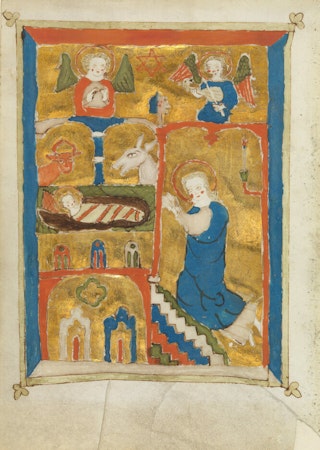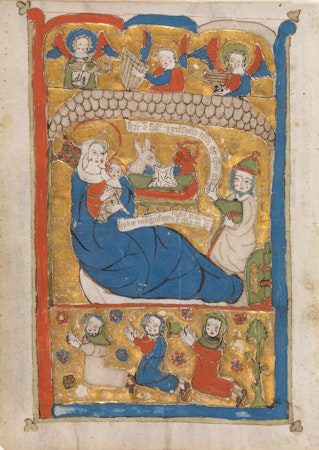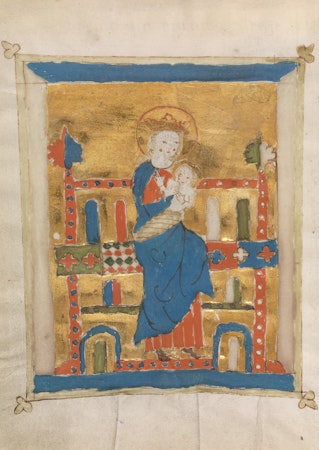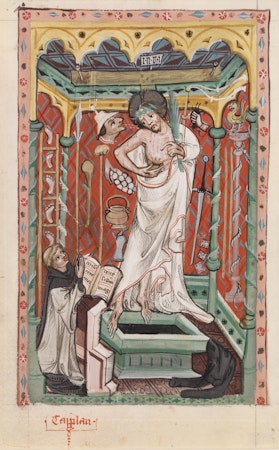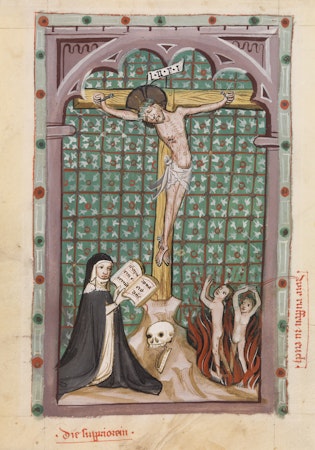Medieval Nuns at the Barnes
By Amy Gillette, research associate
“We know that our own human spiritual life is tied to the body in diverse ways,” wrote Saint Edith Stein (1891–1942), a philosopher and Catholic nun of Jewish origin who died at Auschwitz.¹ Though this tie may be experienced as a “burdensome chain which impedes the flight of the spirit,” she continued, the nature of the body isn’t to impede the spirit. Instead, Stein said, the body can be an instrument of spiritual self-expression.
Stein’s great intellectual achievement was bridging phenomenology (the study of how we experience things) and Christian theology (especially the works of the Dominican friar Saint Thomas Aquinas, d. 1274).² Her perspective is a compelling one for looking at a small group of religious objects in Room 16 of the Barnes collection. Displayed in frames along the east wall, these colorful manuscript miniatures from late medieval Germany were made by and for nuns (Fig. 1). Dr. Albert C. Barnes bought all seven together in Munich in 1930.³
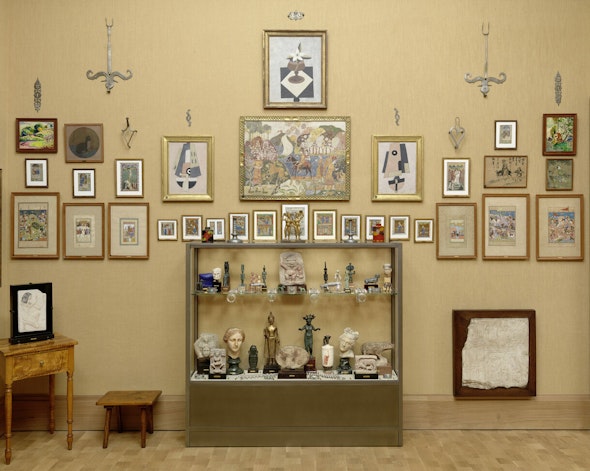
Fig. 1. The east wall of Room 16 of the Barnes collection.
The miniatures are in two sets: the first, five scenes of Jesus as a baby (Figs. 2a–e); the other, two of his Passion (Figs. 3a–b).
Medieval nuns treasured devotional images, using them privately and when performing the Divine Office (the daily prayer cycle).⁴ How did they interact with these images? It may be helpful to engage Stein’s view of an artwork as an idea that an artist brings into Dasein, or “being-there,” an active mode of existence characterized by an ongoing involvement with one’s surroundings, distinct from the passive existence of other objects.⁵ Once brought into Dasein, the artwork can be an agent of spiritual growth. It can provide a structure to understand transcendental being, as well as ethical or mystical content to emulate (in Stein’s words, “with the production of the external expression will the inner image be fully formed and interiorly adopted, [urging people] to effectively reproduce it in action”).⁶ The idea informing both sets of miniatures is the mystery of Jesus’s human body, and both sets uphold the body (his and the viewer’s) as an instrument of spiritual self-expression.
Christ’s Infancy
The Infancy miniatures (Figs. 2a–e) date to the late 1300s. The somewhat patchy painting indicates they were made by nonprofessional artists, most likely by nuns in their convent.⁷ There are three scenes of Jesus’s Nativity and two of the Virgin and Child Enthroned. Stitching along the sides suggests the works were bound into prayerbooks at some point—likely different ones, given the repetition in subject. The miniatures might have been made as standalone devotional items—gifts that the nuns made for one another.
Let’s look first at one of the Nativity images (Fig. 2a). Under a fanciful arched structure, the newborn Jesus lies swaddled in a manger, and his mother, the Virgin Mary, kneels in prayer on a multicolor flight of stairs. Such a building would have constituted a “structure to understand transcendental being.”⁸ Above, a star shines between two angels, who pray and play a viol (medieval violin). The scene captures what was, at the time, a very recent event: a vision of Christ’s birth that Saint Bridget of Sweden (founder of the Bridgettine order of nuns) experienced in 1372 at the Church of the Nativity in Bethlehem. She described Mary’s kneeling posture, a candle on the wall, and the “sweet and most dulcet songs of the angels”:
When [Joseph and Mary] had entered the cave, and after the ox and the ass had been tied to the manger, the old man went outside and brought to the Virgin a lighted candle and fixed it in the wall and went outside. . . . And when all these things had thus been prepared, then the Virgin knelt with great reverence, putting herself at prayer . . . and then and there, in a moment and the twinkling of an eye, she gave birth to a Son, from whom there went out such great and ineffable light and splendor that the sun could not be compared to it. . . . And then I heard the wonderfully sweet and most dulcet songs of the angels. . . . When therefore the Virgin felt that she had now given birth, at once, having bowed her head and joined her hands, with great dignity and reverence she adored the boy and said to him: “Welcome, my God, my Lord, and my Son!”⁹
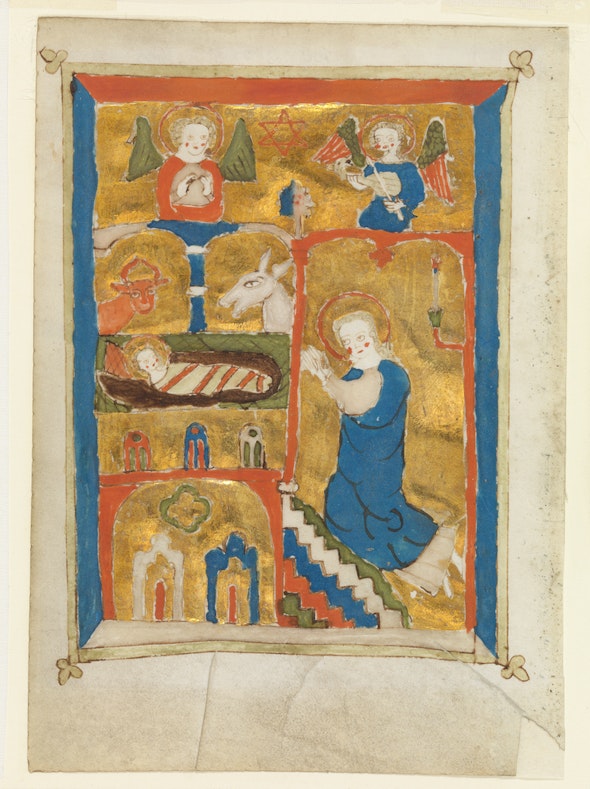
Fig. 2a. German. The Nativity, late 14th century. BF1046
Another work of art that captures tender devotion to the baby Jesus—and expresses it explicitly as a multisensory experience of mothering—is a 15th-century cradle from the Grande Béguinage of Louvain, Belgium, now at the Metropolitan Museum of Art (Fig. 4). Created to hold a doll of Jesus, the crib has the pointed windows of a Gothic church. Witness, too, the angel musicians and the garlands of bells strung between them to play their “dulcet songs” of comfort and joy.¹⁰

Fig. 4. South Netherlands (made in Brabant for the Grande Béguinage in Louvain). Crib of the Infant Jesus, 15th century. Metropolitan Museum of Art, New York (1974.121)
The theme of the Virgin and Child Enthroned meditates further on Jesus’s simultaneous babyhood and divinity. In Enthroned Virgin and Child (Fig. 2b), Mary holds Christ on her lap on an otherworldly throne. The throne’s ornate bandwork evokes metalwork casket shrines (containers for relics), such as the bejeweled Limoges Adoration shrine at the Hermitage (Fig. 5).¹¹ Its flowering vines allude to the Tree of Jesse, a prophecy of Jesus’s human ancestry through Mary, and, poignantly, to Jesus’s eventual self-sacrifice on the “living Cross,”¹² a scene also depicted in the Psalter of Abbot Robert of Lindsey, where the Cross blossoms with roses and lilies.¹³ The scriptural reference here is Canticles 2:1—“I am a rose of the field, a lily of the valley”—interpreted as a song of mutual love between Christ and Church, as groom and bride. This yearning for spousal union with Christ is also depicted in the Rothschild Canticles (c. 1310–20, likely made for a nun), with surprising sensuality; the accompanying text excerpts the Confessions of Saint Augustine (354–430): “I call you, my God, into my soul, that prepares to seize you out of the desire you have inspired within it” (Fig. 6).¹⁴

Fig. 5. French (Limoges). Reliquary Casket with Scene of the Adoration of the Magi, 13th century; completed 19th century. Hermitage Museum, St. Petersburg, Russia

Fig. 6. Flanders or the Rhineland. “I call you, God, into my soul,” folio 66r in the Rothschild Canticles, c. 1300. Beinecke Rare Book and Manuscript Library, Yale University (Beinecke MS 404)
Christ’s Passion
Christ as the Man of Sorrows and Crucifixion make up the second group of nuns’ miniatures (see Fig. 3a–b).¹⁵ They embody the Central European “Beautiful Style” and must have belonged to a Dominican convent, given the black-and-white habits worn by figures of a friar (Man of Sorrows) and a nun (Crucifixion). The nun is labeled in German Die Suppriorein (“the Sub-Prioress”), and the friar Caiplan (“Chaplain”); he would have performed the priestly duties for the convent, such as confession and Mass.¹⁶ The parent manuscript seems to have been a breviary—a liturgical book containing the text of the Divine Office.¹⁷ This identification is affirmed by some just-deciphered notes on the back of Crucifixion, promising to “keep the above-written anniversary eternally and diligently every year.”¹⁸

Fig. 3a. German. Christ as the Man of Sorrows, late 14th century
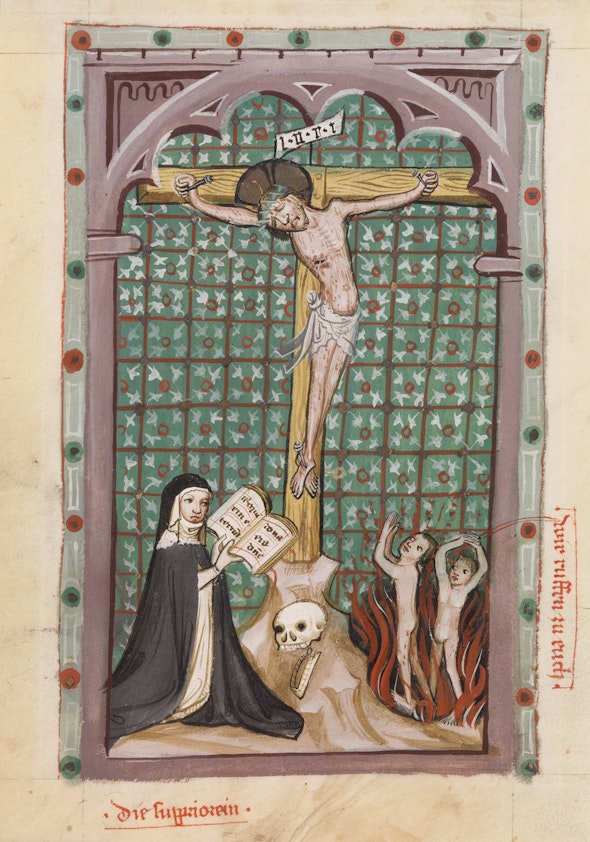
Fig. 3b. German. The Crucifixion, late 14th century
In Man of Sorrows, the friar prays beside a book open to Psalm 51 (read in the Office of the Dead, at Lauds): “Have mercy on me, God, according to your great mercy” (Miserere mei, Deus, secundum magnam misericordiam tuam). But he gazes instead at the wound that Jesus (standing above an open sarcophagus, and under an altar canopy) holds open for him.¹⁹ The top of the Cross is visible behind Jesus, and all around him float further instruments of his Passion—including the lance that pierced his side, a scourge, a spitting antagonist, and dice that soldiers used to gamble to win his garments.²⁰
In the Crucifixion miniature, the nun kneels beside Christ’s body and reads from an open book. We can see the opening words of the intercessory Requiem prayer, read toward the end of the Office of the Dead: “Give them eternal rest, Lord” (Requiem æternam dona eis, Domine).²¹ Opposite, two small naked souls plead from the flames of purgatory. The adjacent German label translates the first line of Psalm 130: “Out of the depths [we] have called to you [Lord].”²² A third miniature at the Staatliche Museen in Berlin, likely from the same set, shows a nun (identified as “the Sacristan”) poised to read the next verse of the Requiem prayer: “And let perpetual light shine on them” (Fig. 7).
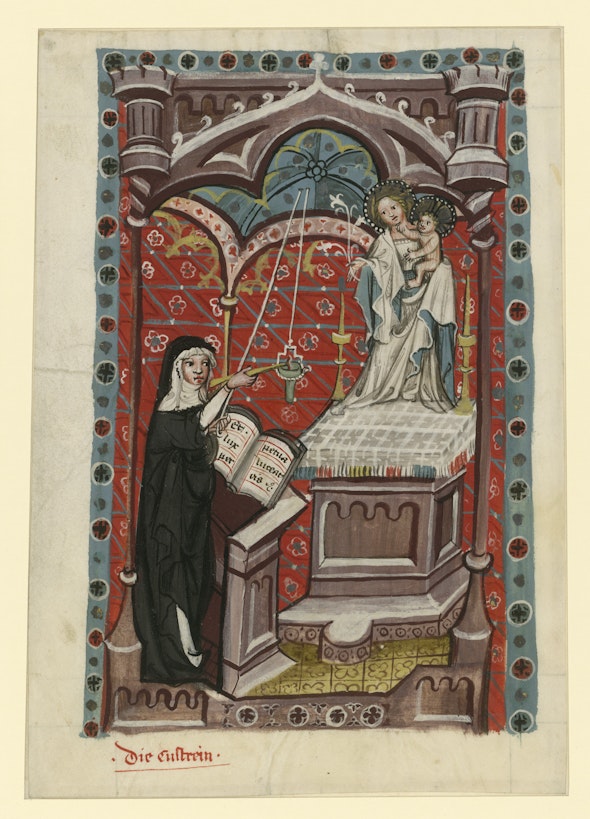
Fig. 7. German, Austrian, or Bohemian. Sacristan Lighting an Altar Lamp, 15th century. Staatliche Museen, Berlin (Min. 12834)
Art historian Jeffrey Hamburger, an authority on the visual culture of medieval nuns, connects the Berlin image to an intriguing passage from Abbess Anna von Buchwald's choir book (1471–87), in which she writes about furnishing her church with a mechanical statue of the Virgin Mary that dispenses sacramental wine through a chalice and copper hand!²³ Images of the Crucifixion and Christ as the Man of Sorrows, of course, served as supreme sites of “corporeality in service of spirituality” for nuns (as for all Christians). Gertrude of Helfta (another nun) recorded, for example, “I made a certain person undertake to say for me each day during her prayers before the Crucifix these words: ‘By your wounded heart, most loving Lord, pierce her heart with the arrow of your love.’”²⁴
And at a Bridgettine convent in Altomünster, Germany, nuns prayed before “an image of mercy,” most likely a Man of Sorrows.²⁵ From their prayers, they fashioned “an exquisite [spiritual] fountain with five golden pipes and drains, that flowed so full of grace to wash away sin. . . . [T]he living fountain is Jesus Christ hanging on the Cross.” A quote by anchorite Julian of Norwich (c. 1343–after 1416), in which she compares Jesus to a nursing mother, further illuminates the reference to the fountain: “The mother can give her child to suck of her milk, but our precious Mother Jesus can feed us with himself, and does, most courteously and tenderly, with the blessed sacrament. . . . Our tender Mother Jesus can lead us into his blessed breast through his sweet open side, and show us there a part of the godhead.”²⁶
To conclude, let’s think a bit more about why the miniatures focus so intently on Jesus’s body. In short, the doctrine of bodily resurrection (including his own) meant that his Incarnation mattered not only historically (through his birth and death) and liturgically (through communion), but also eternally. Thus, Thomas Aquinas stated, “The soul . . . is not the whole person, and I am not my soul.”²⁷ Medieval scholar Caroline Walker Bynum explains that, in the Middle Ages, people understood themselves to be a unity of soul, mind, and body. Even in heaven, their souls wouldn’t quite be "themselves" until reunited with their bodies (which people believed would happen upon Jesus’s Second Coming). And furthermore, during life on earth, the notion that sensory perception involved the three facets of the self “tended to undercut a sharp distinction between [them].”²⁸
The belief in soul-mind-body integrity helps illuminate how nuns would have viewed their miniatures, as active objects of engagement. Edith Stein wrote, “The senses are bodily organs but at the same time, they are windows of the soul through which it gains knowledge of the external world. . . . The senses deliver the matter with which spirit occupies itself,” such as works of sacred art.²⁹ Following this delivery, the process of meditation can make said matter spiritually meaningful, and thereby mold the viewer’s will:
“The occupation in which the spirit interiorly assimilates the content of faith is called meditation. Here the imagination presents itself with images of events in salvation history, seeks to plumb their depths with all the senses, weighs with the intellect their general meaning and the demands they place on one. In this way the will is inspired to love and to resolve to form a lifestyle in the spirit of faith,” including in the face of crises like Nazism.³⁰
The purpose of this Research Note is to understand a collection of medieval miniatures made for Christian nuns, who longed for union with the body of Jesus. But Stein’s phenomenology can apply more broadly. For instance, you might ask yourself: Have your body and senses ever been agents of uplift, or even enlightenment, for you? Have works of art at the Barnes been part of this experience, even to the extent of shaping your inner life? And what would it be like to embrace the body as an integral, positive aspect of being a person?
Endnotes
¹ Edith Stein, Finite and Eternal Being, trans. by Kurt F. Reinhardt (Washington, DC, 2002), 91.
² Stein earned her PhD in 1916 at the University of Freiburg, under the direction of Edmund Husserl. While teaching at a Dominican nuns’ school in Speyer from 1923 to 1931, Stein translated Aquinas’s De Veritate into German and wrote “Husserl and Aquinas: A Comparison” (1924). Later in her career, she also worked closely with texts by the Pseudo-Dionysius, Duns Scotus, Saint Teresa of Avila, and John of the Cross.
³ Dr. Barnes purchased the following manuscript miniatures from Jacques Rosenthal on December 11, 1930: BF1044, BF1045, BF1046, BF1047, BF1048, BF1049, BF1050, BF1051, BF1052, BF1053, BF1054, BF1055, and BF1056ab. Barnes Foundation Archives, letter and inventory from Rosenthal to Dr. Barnes, December 14, 1930 (AR.ABC.1930.458).
⁴ Jeffrey F. Hamburger and Robert Suckale, “Between This World and the Next: The Art of Religious Women in the Middle Ages,” in Hamburger and Susan Marti, eds., Crown and Veil: Female Monasticism from the Fifth to the Fifteenth Centuries (New York: Columbia University Press, 2008), 97.
⁵ Stein, “Artistic Truth,” in Finite and Eternal Being, 300–305. The artist calls a work of art into Dasein by means of their idea for it. For this and other concepts, Stein engaged in discourse with numerous philosophical predecessors and colleagues—for example, Martin Heidegger, The Origin of the Work of Art (first delivered as a lecture in 1935).
⁶ Cf. Stein’s treatment of the question “Is a philosophic study of angels possible?” in Finite and Eternal Being, 380–90. She cites Thomas Aquinas, who figured that the “sensible shapes in which [angels] at time appear to human beings are produced by them in the manner of a handiwork [Werk, opus], so that by means of these visible shapes [angels] may make themselves intelligible to creatures whose knowledge is tied to sense perception.”
⁷ In the inventory he sent to Dr. Barnes, Rosenthal described BF1046 as “Deutsche Malerei aus einem Frauenkloster” (“German painting from a convent”). Comparanda for the Nativity/Virgin and Child miniatures include a late-14th-century embroidery in the Cloisters made by nuns in Lower Saxony under the direction of their abbess or prioress (MMA 69.106); and Princeton Art Museum y1031, a cutting from a choir book featuring Saints Martha, Agatha, and Elizabeth, shown as Fig. 7 in Hamburger, Nuns as Artists: The Visual Culture of a Medieval Convent (Berkeley: University of California Press, 1998).
⁸ Concerning the architecture: the nuns who created the Barnes miniatures may have engaged the medieval notion of memory as a “thinking machine,” cultivated partly by erecting mental buildings as heuristic devices for internalizing information, such as the history and mystery of Christ’s Incarnation. One of the most frequently cited passages on this approach is by Pope Gregory the Great (d. 604): “First we put in place the foundations of literal meaning [historia], then we build up the fabric of our mind in the walled city of faith; and then at the end, through the grace of our moral understanding, as though with added color, we clothe the building.” See Mary Carruthers, The Craft of Thought: Meditation, Rhetoric, and the Making of Images, 400–1200 (Cambridge: Cambridge University Press, 1998).
⁹ Saint Bridget of Sweden, Prophecies and Revelations, VII, 21. The angels’ music represents the Gloria in excelsis hymn celebrating Christ’s birth in Luke 2: “Suddenly a great company of the heavenly host appeared with the angel, praising God and saying, ‘Glory to God in the heavens, and on earth peace to people of good will.’”
¹⁰ The image develops the iconography of the Throne of Wisdom, in which Christ as Wisdom Incarnate sits on the Virgin’s lap as upon a throne. The 12th-century wooden sculpture A437 is an example at the Barnes.
¹¹ Object entry for the Limoges casket.
¹² See Genesis 2:9 for the Trees of Life and Knowledge; Revelation 22:1–2 for the Tree of Life (Lignum vitae); the text Regnavit a ligno Deus from the Latin text of Psalm 95:10; and the text Ascendam in palmam of Canticles 7:8. Paul Binski, Becket’s Crown: Art and Imagination in Gothic England, 1170–1300 (New Haven: Yale University Press, 2004), 212.
¹³ Binski, Becket’s Crown, 214–15 for the Psalter of Robert of Lindsey, and 222–30 for a discussion of sweetness.
¹⁴ Digitized Rothschild Canticles (Yale University Library, Beinecke MS 404).
¹⁵ The Man of Sorrows is a type of devotional image that refers to the Old Testament verse Isaiah 53:3, a prophecy of the Messiah: “He is despised and rejected of men, a man of sorrows, and acquainted with grief.”
¹⁶ William Wixom associated BF1044 and BF1045 with the Beautiful Style in unpublished notes on these objects. Rosenthal described the style as: “Süddeutsch. Um 1430. Wohl aus dem fränkischen Kunstkreis unter östlichen Einfluss” (“Southern German, around 1430, probably from the Franconian art circle under Eastern influence,” writing about BF1045). For a discussion of the Beautiful Style, see Gerhard Schmidt, “The Beautiful Style,” in Prague: The Crown of Bohemia, 1347–1437, exh. cat. (New York: The Metropolitan Museum of Art, 2005), 105–12. The chaplain’s priestly duties must be why the Man of Sorrows miniature fuses Christ’s historical passion with the communion rite of the Mass—for example, by framing the scene with an altar canopy.
¹⁷ For definitions of the types of medieval devotional manuscripts, see “The Art of Devotion in the Middle Ages” (Getty Museum). For the Office of the Dead in Latin and English, see here.
¹⁸ With profound thanks to Violet Lutz (YIVO Institute for Jewish Research, New York) and Amey Hutchins (Schoenberg Institute of Manuscript Studies, University of Pennsylvania) for translating this text. Its last legible line reads: “in order that everything happens and is completed concerning the abovementioned visitation to/of [?] our dear friend, as one counts after Christ our . . .” [prelude to writing the date].
¹⁹ Saint Bernard of Clairvaux was a pivotal figure for developing the tradition of devotion to Christ’s wounds, in his sermons on Canticles and in the following prayer: “Wounds of blood-red ruby droplets,/ Driven deep-set as in goblets:/ These inscribe upon my heartbeat,/ Make my joining to you replete—/ At every moment loving you.” “Vision of Saint Bernard,” Feminae: Medieval Women and Gender Index.
²⁰ These tokens of Christ’s Passion were known as the Arma Christi and served as mnemonic devices. The spitting antagonist is an antisemitic image of a Jewish person.
²¹ The Requiem was prayed for the faithful dead, partly to hasten their souls out of Purgatory.
²² Psalm 130 was read in the Office of the Dead at Vespers.
²³ Hamburger, The Visual and Visionary: Art and Female Spirituality in Late Medieval Germany (New York: Zone Books, 1998), 100, Fig. 1.36. The same miniature is illustrated in Crown and Veil, 47, Fig. 2.1 (in the context of explaining the spatial arrangements of convent churches. Sometimes the sacristy would be situated within the nuns’ enclosure). Hamburger, writing in the 1990s, does not seem to have known about BF1044 and BF1045.
²⁴ Gertrude of Helfta, Oeuvres spirituelles, qtd. in Hamburger, The Visual and Visionary, 102.
²⁵ Qtd. from the medieval text “Die geistliche Padstube” in Hamburger, The Visual and Visionary, 79.
²⁶ Julian of Norwich, Showings, trans. Edmund College and James Walsh (New York: Paulist Press, 1978), qtd. in Caroline Walker Bynum, Fragmentation and Redemption: Essays on Gender and the Human Body in Medieval Religion (New York: Zone Books, 1992), 164.
²⁷ Saint Thomas Aquinas, Letter on 1 Corinthians (13th century). Qtd. in Bynum in Fragmentation and Redemption, 229.
²⁸ Bynum, “Patterns of Female Piety in the Later Middle Ages,” in Crown and Veil, 184. For further analysis in this volume of nuns’ devotion to Christ’s humanity: see pages 85 (love of Christ and Church, often in the person of Mary, expressed as bridal mysticism as interpreted by Saint Bernard of Clairvaux’s sermons on Canticles); 163 (penitential piety; the “violence directed against the nuns’ own bodies coexisted with a tender, even sentimental piety focused on the child Jesus (the object of joyful longing) and the crucified Christ (the object of tearful compassion)”).
²⁹ Stein, The Science of the Cross, in Edith Stein: Selected Writings (New York: Paulist Press, 2016), 171.
³⁰ Stein, The Science of the Cross, 174.

